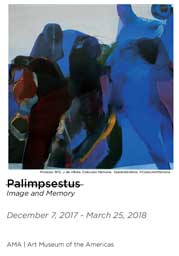Palimpsestus: Image and Memory
Organization of American States
Secretariat for Hemispheric Affairs
AMA | Art Museum of the Americas
201 18th Street NW
Washington DC 20006
December 7, 2017 - March 25, 2018
Thursday, September 7, 6-8pm
Opening reception
RSVP
Hours: Tuesday-Sunday 10am-5pm
The Organization of American States (OAS) AMA | Art Museum of the Americas, in collaboration with the Permanent Mission of Mexico to the OAS, and the Mexican Cultural Institute, present Palimpsestus: Image and Memory. The seventy artworks on display, produced between 1900 and 2014, include more than 30 artists from ten different countries drawn from Colección Memoria, assembled around artistic activisms by exhibition curator Alejandro de Villota Ruiz, and a selection of iconic modern and contemporary pieces from OAS permanent art collection.
Palimpsestus: Image & Memory surveys the main artistic trends and visual cultures that have developed in Latin America in the second half of the 20th Century. The term Palimpsest, a capitalistic practice stemming from the scarcity of paper as a good for fifteen centuries, is appropriated by the curator to conceptualize the relativity and interrelation of art narratives and aesthetic discourses. It explores art movements from abstraction to new figuration as well as collective memory, through an experimental curatorial exercise based on anachronistic and antagonistic visual essays. Taking its methodological frame from Aby Warburg’s Atlas Mnemosyne and from Harald Szeemann’s catalyst exhibitions, Palimpsestus aims to become a posteriori and an empirical source of interpretation and critical thinking.
Three axes of the curatorial script deconstruct artistic linear chronologies and geographical artistic paradigms, in an attempt to discover the primitive traces that remain invisible along the surface of our contemporary visual culture. Firstly, mainstream aesthetics are introduced in A(rt)nachronism, followed by two subsequent curatorial universes, The Bestiary, and Diaspora: Reconstructing Identities reflecting on the exile of artists to Latin America during the Spanish Civil War (1936-1939), which operate both as parallel and underlying imaginaries to canonic views.
The exhibition’s core lies in the Bestiary, containing The Grays (1970 – 1976) by the Spanish artist Javier de Villota (b. 1942, Madrid) referring to the popular name of Franco´s armed police forces. These 20 drawings mark the entry into a convulsive period initiated with the ‘68 student movements’ extension, the unrecognized Nigerian secessionist nation of Biafra (1967-1970), and the ‘70s decade, during which active dictatorial regimes existed both in Europe and in Latin America, and where freedom of expression and other liberties continued to be an illusion in many countries around the globe.
Palimpsestus: Image and Memory is part of AMA’s exhibitions program showcasing contemporary artists of OAS member countries. AMA is part of the OAS’s Secretariat for Hemispheric Affairs, and its work is based on the principle that the arts are transformative for individuals and communities, as visual components reflecting the four pillars of the OAS: democracy, human rights, security and development.
Exhibition Artists: Yolanda Andrade, José Balmes, Gracia Barrios, Luis Brito, Roser Bru, Juan Carlos Cáceres, Inés Córdova, Carlos Cruz-Diez, José Luis Cuevas, Ernesto Deira, Juan Downey, Paz Errazuriz, Roberto Fanztozzi, Marisa González, Muriel Hasbun, Graciela Iturbide, Gyula Kosice, Guillermo Núñez, Roberto Matta, Leopoldo Méndez, Pedro Meyer, Marco Ugarte, José Clemente Orozco, Marta Palau, José Guadalupe Posada, Roberto Schettini, Javier Silva Meinel, Joaquín Torres García, Jorge de la Vega, Osvaldo Vigas, Alejandro de Villota, and Javier de Villota.
Accessibility: AMA’s first floor is wheelchair accessible by appointment, with a ramp that can be installed at the back entrance to the museum. There is a gravel pathway leading to the back entrance. There is one half-step leading from the first room into the first-floor galleries. There is a flight of winding stairs leading to the museum’s second floor. Restrooms are located on the second floor. For more information on accessibility, or to make an appointment to visit, please contact 202 370 0147 or artmus@oas.org
AMA appreciates the support of the following sponsors:
FAMA | Friends of the Art Museum of the Americas
Permanent Mission of Mexico to the OAS
Mexican Cultural Institute
Colección Memoria – Alejandro de Villota
Amexcid
Spain Arts + Culture – Spanish Embassy in Washington
Aeromexico
For more information on AMA, please visit AMAmuseum.org


